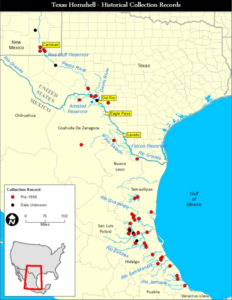The Texas Hornshell (Popenaias popei) is a mussel found in New Mexico and Texas. This freshwater mussel lives in shallow, slow running water in caves and beneath rocks. The Texas hornshell grows up to about four inches long and can live up to 20 years. In 2005, the Texas Hornshell was listed as a candidate for listing under the Endangered Species Act, and in August 2016, the U.S. Fish and Wildlife Service (FWS) proposed to list the mussel as endangered. The species has been impacted by sedimentation, loss of flowing water, and impairment of water quality, and include impacts such as stream-diversions for municipalities and agriculture, loss of riparian vegetation from grazing by livestock, and increasing salinity caused by excessive diversion of river water for irrigation.
Where does the Hornshell exist?
According to the Fish and Wildlife Service’s species assessment the Texas Hornshell can be found near Big Bend National Park, near Laredo in Webb County, Texas, in the Pecos River near Pandale, Texas, the Devil’s River in Val Verde County, Texas, and Eddy County, New Mexico. Today, it is the only native mussel remaining in New Mexico and Texas.
What is being done now to protect the species?
Fish and Wildlife is currently working with stakeholders to develop voluntary conservation agreements to conserve the Texas Hornshell as well as 4 other species. Officials in New Mexico and Texas are currently developing a Candidate Conservation Agreement with Assurances (CCAA) for state and private lands in which participating landowners and companies that implement conservation measures will receive assurances that if the species is listed they will not face additional land management restrictions. Stakeholders are also developing a Candidate Conservation Agreement (CCA), which would implement similar conservation practices on federal lands and minerals in New Mexico. However, this effort is in addition to the numerous laws and regulations that the oil and gas industry follow to ensure its operations are conducted in a manner that protects the environment and surrounding habitat.
Should the Hornshell be listed?
Fish and Wildlife is expected to provide a listing decision on or near August 10, 2017 on the Hornshell. As IPAA laid out in previous 2016 comments on the species, the Service has inadequate data to make a science-based listing determination for the species. As the industry’s comments state, “the best scientific data available for a significant portion of the species’ range are the surveys conducted in the 1980s, then the Trades believe the requirements of the Act have not been met, and that the Act requires the Service to determine that a listing of the species is not warranted. At a minimum, due to the uncertainty of whether the species is currently found in Mexico, which constitutes a significant portion of the species’ range, the Trades contend that there is insufficient data to warrant an endangered listing for the Texas Hornshell.”
If new data indicates the species should be listed, the oil and natural gas industry should be treated in an appropriate manner as its operations do not impact the areas where the mussel occurs. Industry practices and the terms and conditions of the permits under which we operate for drilling, production, gathering, and transportation activities set requirements and provide guidelines to prevent this from occurring. In fact, development and water use in Texas and New Mexico is subject to a strict permitting regime that provides the Texas Hornshell and its habitat a level of protection greater than that afforded by the Endangered Species Act.

